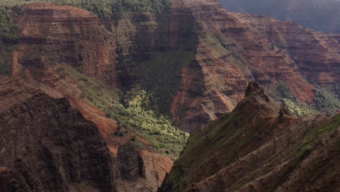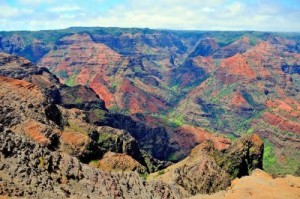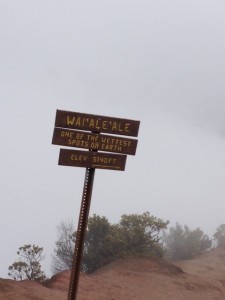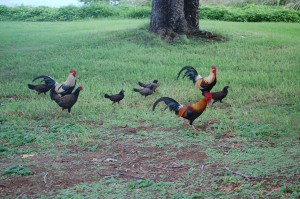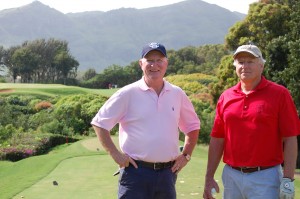Editor’s Note: During this difficult time dealing with the Coronavirus outbreak, leaving golf writers nothing to write about, we decided to revisit some of the places we have gone over the years. Today, we to take a look around Kauai.
KAPAA, Hi. – Water, water everywhere, falling here and there, giant waterfalls with dramatic drops over volcanic rock, cascading hundreds of feet into great pools filled with raven-haired native beauties and Iowa tourists.
We found the Iowans. Not so much anything else.
During our Kauai Grand Slam golfing tour here we had time to venture out into the interior of the island in search of the great waterfalls. My daughter and son-in-law had visited Kauai a month earlier and reminded us, “make sure you see the canyon and the waterfalls.”
There are several canyons and a multitude of falls on this island. Our fault is that we didn’t really get an exact location. The only falls we saw were in the distance, thin white lines against the dark green mountains, partially hidden by fog. We wanted to get close enough to feel the spray in our faces.
When we asked the locals where “the falls” were, they’d looked at us like we had three heads. They’re all over. There’s the Waipoo Falls, the Wailua Falls, the Hanakapiai Falls, the Manawaiopuna Falls.
The double-sprouted Wailua Falls was in the opening scene from the old TV show “Fantasy Island.” The Manawaiopuna Falls was featured in the movie ‘Jurassic Park.”
It was finally determined that Wailua was the falls and the ‘canyon’ that everyone said was the must-see was Waimea. They are both in the same direction, from the Lihue Airport you drive south along Hwy 50 then right onto Hwy 552 and up the twisting canyon road. We were told to drive “until you reach a parking lot” where the road ends. The waterfalls, surely, must be nearby.
They didn’t exactly tell us what we’d see when we got there and when we did get there we didn’t exactly see anything. Fog and mist were our constant veils.
The road up 552 is a long series of doglegs left and right, with plenty of one-lane road work delays. We stopped along the way two or three times to gaze at the Waimea Canyon, a miniature Grand Canyon in appearance. Mist filled many of the gaps but it’s massive enough to see down to several sun-speckled valleys. Definitely worth the trip.
The ‘parking lot’ at the end of the road was Kokee State Park. At this elevation, about 3,500 feet, the fog was eye high. It obliterated much of the jagged edges of the canyon cliffs and Mt. Wai’ala’ale. But we saw glimpses. Pretty spectacular.
Yet we had no idea where to find the falls. There were a couple beaten-down mud paths descending into the valley but, without golf shoes, were would have slipped and slid much of the way. The only falls we would have see would have been our own. Besides, the fog permeated the area.
No falls could be seen on the way up and none on the way down.
We stopped for lunch at the cozy small town of Waimea and had a ‘kau kau’ for lunch on the front porch of Wrangler’s Steakhouse. It comes in a tin can stacked with four containers of rice, beef teriyaki, shrimp tempura and veggies. Kau Kaus were used in years past to carry the lunch for Asian workers in the nearby sugar cane fields.
Waterfalls-less, we returned to our accommodations in Kapaa on the eastern coast of the island. Wailua Falls turned out to be elusive but we still satisfied ourselves. At the second-deck, open-air Olympic Cafe in downtown Kapaa, we washed down a few passion-fruit-flavored Wailua Wheat beers. Almost the same thing.
Chickens crossing the roads
What’s with all the chickens, mostly roosters, just about everywhere you look in Kauai? You will see them from the time you step outside at the airport doors to the roadside berms and to parking lots around stores, restaurants and hotels.
The state bird? Hardly. Protected species? No, not in the least. Most residents would like to choke those chickens. They are really just benign pests.
The history of the Kauai chickens goes back more than a century. They were initially brought to the island for food, eggs and meat. They also were used for cock-fighting, a popular activity for the islanders until it was banned in the mid-20th Century.
But what really spread the flock was a pair of hurricanes – Iwa in 1982 and Iniki in 1992 – that devastated the island. The storms busted up the chicken coops throughout the island and freed the chickens. Feral poultry now roam with impunity.
There are no natural predators for the chickens, no coyotes, no snakes or gators. There was an attempt to introduce mongoose to the island decades ago but that was foiled. It likely would have failed. Mongoose were brought to other Hawaiian islands to control the rat population but that didn’t work because the rats are nocturnal and the mongoose are diurnal, otherwise active during the day and sleepers at night.
Natives don’t even want to hunt the chickens. If you have a hankering for a chicken sandwich, these pesky little creatures are to be avoided. They have been described as gamey and wormy. The joke on the island is that if you put a rock and one of these chickens in a boiling pot at the same time, the rock would be first to be ready to eat.
Roosters are supposed to crow at the break of dawn but not these guys. Anytime of day you’ll hear the long, hoarse cockle-doodle-dos.
And anytime at night.
“A few of them have a screw loose and they’ll start cockle-doodling at 1 in the morning,” Makai’s head professional Ryan Forster said. “Those are the worst ones.”
It’s the state’s foul, not fowl. The elegant Nene geese is the state bird, a smaller Canadian geese-like bird with distinctive markings on its neck. The Nenes are protected and every golf course starter will tell you to avoid feeding, bothering or running over the Nenes. On the other hand, those same starters will tell you, chickens, hit as many as you want.
Buddy trips
Every year, there are groups of guys who make pilgrimages from the Northwest to the Southeast to play the wonderful South Carolina courses. There are Midwest groups that annually fly then drive all day to reach the glorious Bandon Dunes golf complex in Oregon.
Those guys are willing to travel long distances to play the country’s elite layouts. So why don’t they put in the same effort and expense into coming to Kauai? It is, after all, this country, just off-shore. They speak English here and in most cases it’s much easier and quicker to reach for West Coasters than anywhere back East.
Why not Kauai?
“Because your significant others will not let you come here without them,” said T.J. Baggett, director of golf for the Prince course.
“People come to this island to hike, to surf, and all these other activities. We’ve got to make golf part of those activities.”
Indeed, when a Kauai trip possibility is raised, suddenly it turns from a buddy trip to a hubby trip. Guys can’t leave the wives behind, or otherwise risk them not being there when they return.
Kauai and the other Hawaiian courses have the unfortunate perception of being too inviting. They offer too much to do beyond golf. World-class resorts and spas. Great food. Great sights, beaches, pools, trade winds, funny hats and printed shirts.
All those other destinations can’t match what Hawaii can give. Yet when guys float the idea of a buddy trip to Kauai, that balloon is quickly popped. Unless, of course, everyone comes along.
Baggett would like to encourage the buddy system because, as he says, “the golf industry is still in recovery mode in Hawaii.”
Kauai is doing its part. The Prince course at Princeville, the Makia course and Kauai Lagoons have all undergone major expensive renovations within the past few years to enhance their already resplendent facilities. Golf is good here. Golf is world class, as all these courses have been given high honors, including ranking among the top 100 in the world. It’s high-style destination golf. It’s the ultimate buddy trip-land, just not everyone in the family sees it that way.
The natives are friendly, such as the Ricky, the starter at Kauai Lagoons, or Art, the starter at Poipu Bay. They could not be more accommodating. They make you want to come back. As Makai’s Ryan Forster wants golfers to remember, “the golf coursewas awesome and the staff was awesome. That’s what we want. We try to keep everything real personal here.”
He added, “you have it all here.”
Yet, you can’t have it all – without her.
And if all this sounds exceedingly sexist, it probably is, although buddy (guy) trips are by a long measure more prevalent than ‘a traveling sisterhood’ trip. They are a critical component to the golf industry’s health and livelihood. However, same rules apply. If the idea of a golfing ‘sisterhood’ trip is proposed, the guys would insist on coming along. Too much to resist.
Hawaii is gender equitable.
TUESDAY: Kauai Lagoons





